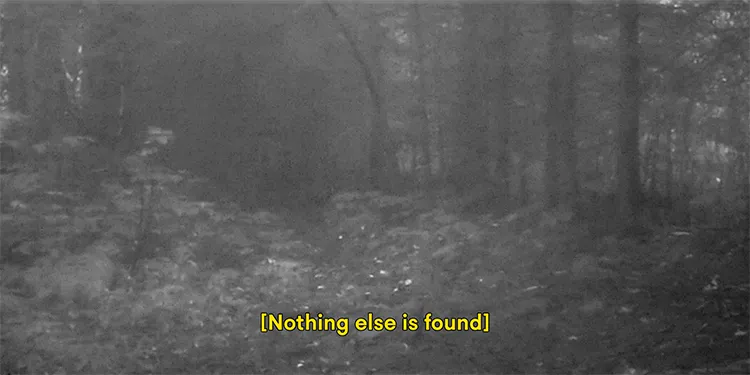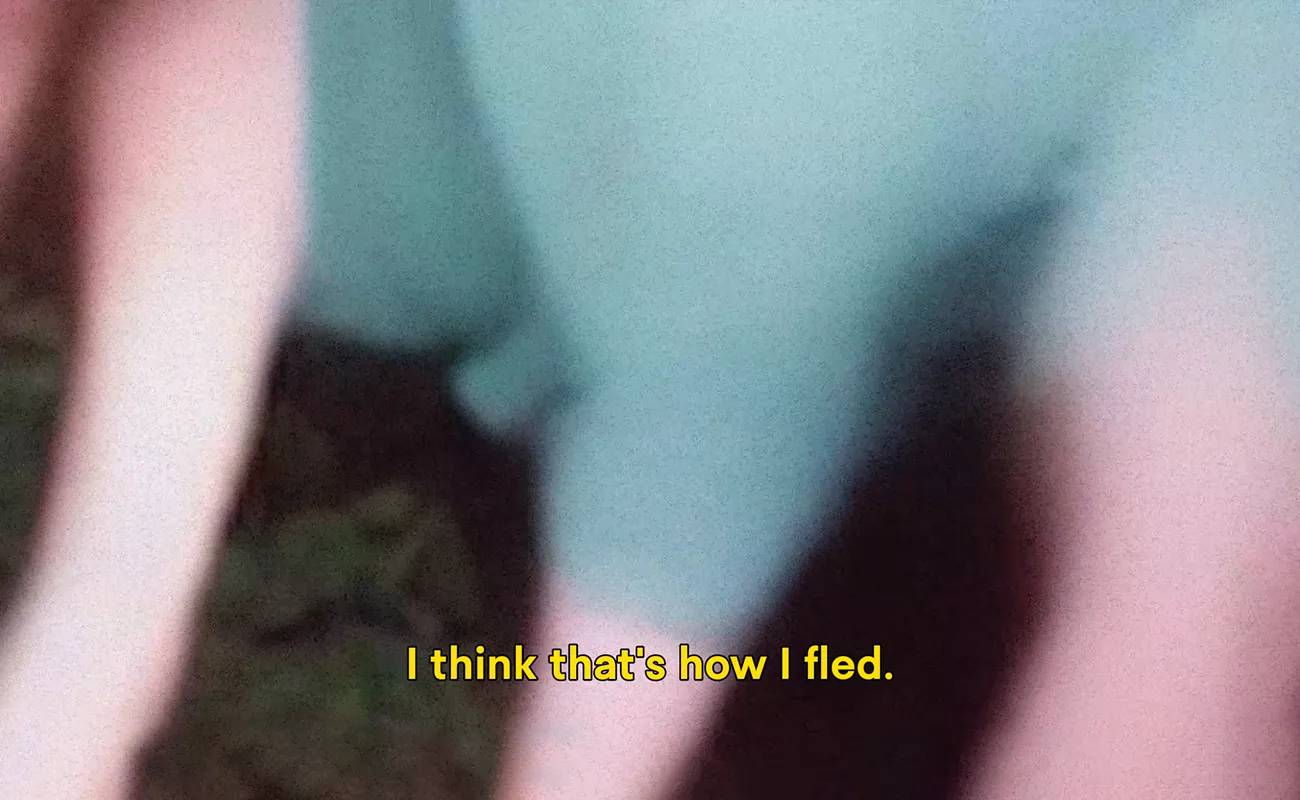“My work seeks the translation of absence/presence in moving images, computer algorithms, and site-specific actions. Central to my practice is an investigation of the layered dynamics between the ‘witnessing’ and the ‘witnessed.'”
An Artist at the Intersection of Media and Performance
Flo Yuting Zhu, born in 1997 in Shanghai and now based in London, is a performance and film artist whose work transcends the boundaries of traditional mediums. Zhu’s practice explores the complex dynamics of absence and presence, using a diverse toolkit that includes moving images, computer algorithms, and site-specific performance. Her art interrogates the act of witnessing—whether in person or through a screen—while seamlessly weaving together popular media forms like vlogs, street games, and horror films. By appropriating these mass-consumed formats, Zhu invites audiences to reconsider the familiar and the mundane, challenging their perceptions of reality and art. Her artistic approach is simultaneously accessible and disorienting, offering an experience that is both immersive and thought-provoking.
Influenced by her early exposure to alternative theatre, Zhu’s approach to art reflects a profound engagement with performance’s transformative potential. Theatre became her first language in artistic expression, inspiring a fascination with how staged or spontaneous actions can elevate the mundane into something deeply significant. Her preoccupation with the themes of presence and absence draws from a personal sense of being intertwined with the media she consumes and creates. This dual relationship of observing and being observed forms the core of her practice, particularly within the context of digital interactions. By drawing on the everyday through widely understood formats, Zhu pushes viewers to reconsider the act of looking and being looked at, expanding the definitions of artistic experience.

Flo Yuting Zhu: Absence, Presence, and the Art of Witnessing
At the heart of Zhu’s artistic philosophy is the investigation of what it means to witness and be witnessed. Her practice often centers on this layered relationship, exploring how the act of observing can transform both the viewer and the viewed. Drawing from her early experiences in theatre, she creates performances that blur the lines between performer and audience, often involving live-streamed or site-specific works. These performances utilize everyday media—vlogs, street games, or even the eerie aesthetic of homemade horror films—to subvert expectations and challenge the conventions of what we understand as ‘real.’ In Zhu’s work, the ordinary becomes the extraordinary through the lens of performance and film.
Much of Zhu’s work draws inspiration from her encounters with experimental theatre, where she observed how performance could break down conventional boundaries and form a shared experience of observation. Alternative theatre’s experimental nature resonated with Zhu, showing her how performance could transform public or digital spaces into interactive canvases. This approach extends beyond theatre as she incorporates found objects and digital tools to craft performances that feel both spontaneous and intricately staged. Zhu’s use of everyday spaces for her art highlights her exploration of presence in a world increasingly mediated by digital platforms, inviting participants to experience her work in surprising ways.
In some of Zhu’s projects, she collaborates with algorithms and artificial intelligence, treating these technologies as creative partners rather than mere tools. This interplay between human and machine adds complexity to her exploration of observation, posing questions about who or what truly engages with the viewer. Her use of algorithms introduces a layered dialogue between natural and digital perspectives, prompting viewers to consider the nature of artistic creation in the technological age. In Zhu’s hands, art becomes a conversation between organic intuition and programmed logic, challenging conventional notions of authorship and agency.

The Influence of Cinema: Horror and Liminal Spaces
Cinema, especially horror, plays a significant role in shaping Zhu’s artistic landscape. She is particularly drawn to directors like Andrzej Żuławski, Abbas Kiarostami, and Koji Shiraishi, whose works navigate unsettling spaces and nuanced portrayals of fear. Żuławski’s Possession, with its raw exploration of femininity, left an indelible mark on Zhu, while Kiarostami’s reflective storytelling influenced her commitment to capturing quiet, immersive moments. Shiraishi’s Noroi, known for its use of fragmented, eerie narratives, echoes Zhu’s own technique of blending the mundane with the otherworldly, creating experiences that are haunting yet familiar.
Zhu’s attraction to horror lies not in its traditional scare tactics but in its ability to explore the unfamiliar within everyday contexts. Rather than relying on shock, Zhu’s work uses horror’s aesthetic of quiet tension, drawing viewers into a world that feels unsettling yet unavoidable. Grainy textures, fragmented storylines, and familiar settings imbued with a sense of dread are hallmarks of her pieces, creating a subtle atmosphere of unease. By invoking horror’s themes, Zhu immerses audiences in liminal spaces where the boundary between reality and imagination becomes porous, inviting them to linger in a state of suspense.
Her interest in liminal spaces reflects her focus on moments of transition and ambiguity. Zhu’s work often inhabits the gap between visible and hidden, much like figures in horror who linger on the periphery of perception. Through found footage, live streaming, and performances, she reveals and conceals aspects of reality, highlighting the tensions between what is shown and what remains unseen. Zhu’s art resonates in this space of ambiguity, urging viewers to question both their perception and the nature of what they witness. By making the familiar appear strange, she compels audiences to grapple with their role as observers in a constantly mediated world.

Flo Yuting Zhu: Crafting Stories Across Media
Zhu’s commitment to interdisciplinary art finds expression in a range of influences, including her profound connection to the play Dots and Lines, and the Cube Formed by Takahiro Fujita. This play, which Zhu encountered as she prepared to transition from Shanghai to London, opened her eyes to storytelling’s possibilities beyond linear narratives. The performance’s fragmented visuals and subtle cues—like a toy dinosaur moving unnoticed in the background or unrelated weather footage—invited Zhu to imagine art as a centerless, boundary-free experience. This revelation catalyzed her desire to break from traditional story structures and embrace a more fragmented, multi-dimensional approach to storytelling.
Building on these insights, Zhu began experimenting with moving images and multiple perspectives, creating works that invite viewers to interpret various, sometimes contradictory, realities within a single frame. Her projects often utilize simultaneous perspectives, reflecting the fractured nature of modern media consumption. Rather than presenting a single cohesive narrative, her work is a mosaic of isolated yet interwoven moments, allowing audiences to construct their own interpretations. This technique mirrors the chaotic, fast-paced nature of contemporary life, underscoring Zhu’s interest in portraying an ever-evolving digital landscape.
Currently, Zhu dreams of taking this exploration further with a project that would involve living entirely off-grid, documenting her isolated existence as an invisible presence within the natural world. Imagining herself as a spectral figure hidden in grass or soil, she would perform in silence, merging with the landscape in a meditative exploration of absence. This concept underscores her continued interest in the dynamics of presence, asking profound questions about witnessing in an environment where the audience is absent. Through this imagined project, Zhu seeks to strip away the expectations of digital spectatorship, examining the significance of observing—and being observed—in a world defined by constant visibility.






